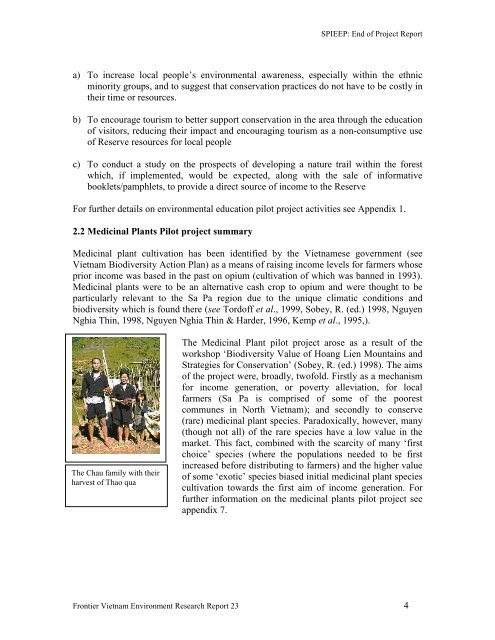Frontier Tanzania Environmental Research - Frontier-publications ...
Frontier Tanzania Environmental Research - Frontier-publications ...
Frontier Tanzania Environmental Research - Frontier-publications ...
You also want an ePaper? Increase the reach of your titles
YUMPU automatically turns print PDFs into web optimized ePapers that Google loves.
SPIEEP: End of Project Reporta) To increase local people’s environmental awareness, especially within the ethnicminority groups, and to suggest that conservation practices do not have to be costly intheir time or resources.b) To encourage tourism to better support conservation in the area through the educationof visitors, reducing their impact and encouraging tourism as a non-consumptive useof Reserve resources for local peoplec) To conduct a study on the prospects of developing a nature trail within the forestwhich, if implemented, would be expected, along with the sale of informativebooklets/pamphlets, to provide a direct source of income to the ReserveFor further details on environmental education pilot project activities see Appendix 1.2.2 Medicinal Plants Pilot project summaryMedicinal plant cultivation has been identified by the Vietnamese government (seeVietnam Biodiversity Action Plan) as a means of raising income levels for farmers whoseprior income was based in the past on opium (cultivation of which was banned in 1993).Medicinal plants were to be an alternative cash crop to opium and were thought to beparticularly relevant to the Sa Pa region due to the unique climatic conditions andbiodiversity which is found there (see Tordoff et al., 1999, Sobey, R. (ed.) 1998, NguyenNghia Thin, 1998, Nguyen Nghia Thin & Harder, 1996, Kemp et al., 1995,).The Chau family with theirharvest of Thao quaThe Medicinal Plant pilot project arose as a result of theworkshop ‘Biodiversity Value of Hoang Lien Mountains andStrategies for Conservation’ (Sobey, R. (ed.) 1998). The aimsof the project were, broadly, twofold. Firstly as a mechanismfor income generation, or poverty alleviation, for localfarmers (Sa Pa is comprised of some of the poorestcommunes in North Vietnam); and secondly to conserve(rare) medicinal plant species. Paradoxically, however, many(though not all) of the rare species have a low value in themarket. This fact, combined with the scarcity of many ‘firstchoice’ species (where the populations needed to be firstincreased before distributing to farmers) and the higher valueof some ‘exotic’ species biased initial medicinal plant speciescultivation towards the first aim of income generation. Forfurther information on the medicinal plants pilot project seeappendix 7.<strong>Frontier</strong> Vietnam Environment <strong>Research</strong> Report 23 4
















